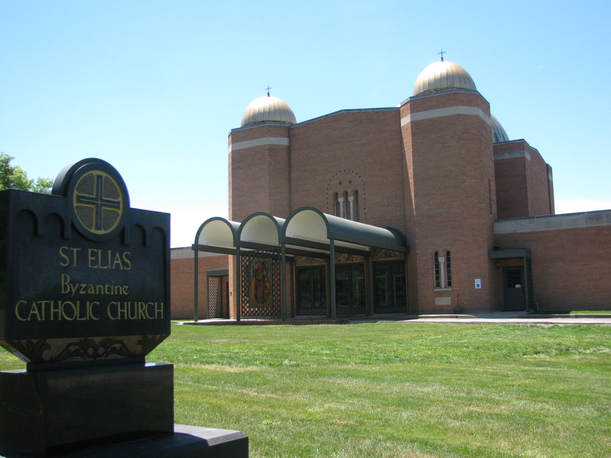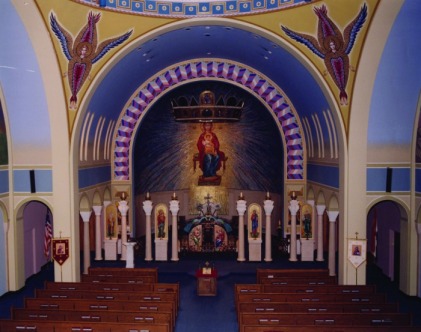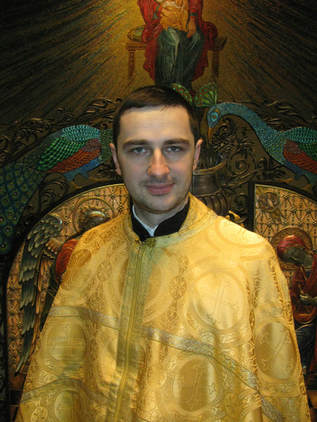Our Heritage
In the latter part of the 1800's and early 1900's many emigrants from Hungary, especially the provinces of Ung, Borsod, and Zemplen came to the United States and settled along the banks of the Monongahela River in the Homestead area. In 1904, Hungarian Greek Catholics (now known as the Byzantine Rite) organized the St. Mary Sick and Benefit Society and a year later in 1905, the name was changed to St. Anthony Sick and Benefit Society of Homestead and Vicinity. The membership of 325 families and 650 singles voted to establish a church.
These Hungarian people, however, had a burning desire in their hearts to worship God in their native tongue and in their own nationality church. On May 4, 1905, a convention of Hungarians from all parts of the Monongahela Valley was called under the leadership of Rev. Andrew Hodobay, Apostolic Administrator and Visitator. Ecclesiastical approval was granted in 1907, after eighteen different delegations had appeared at the Chancery. The choice of our Patron Saint was named. St. Elias was a natural choice for our patron saint, as he had long been the patron of good crops among the Hungarian people of the soil. The ikon of St. Elias in front of the church calls all Christians to worship the one true God according to the Gospel preached by Christ and to be a Christian at all times without compromise. Due to the trend of the populace moving to the suburbs, the new parish site of thirteen acres of land on Homestead-Duquesne Road was purchased in 1961. The new site underwent development and Edward F. Horley was engaged as the architect and the plans for the new church, social hall, rectory and classrooms were developed. A culmination of dreams became reality on July 24, 1966, the new St. Elias Byzantine Catholic Church was dedicated with His Excellency, the Most Reverend Nicholas T. Elko, D.D. officiating.
From 1908 to present, the members of St. Elias Church were served by Rev. Julius Orosz, Rev. S. Roskovics, Rev. J. Kovalcsik, Rev. V. Kizak, Rev. E. Suba, Rev. N. Szabo, Rev. Basil Ivancso, Rev. Albert Gajdos, Rev. Valentine Orosz, Rev. George N. Vida, Rev. E. Lucas, Msgr. R. Balta, Rev. D. Valasek, Very Rev. Archpriest Eugene Yackanich, Very Rev. Andrew J. Deskevich and Rev Fr. Vitalii Stashkevych.
The history of the realization of our St. Elias Church would not be complete without some mention of the many hours of work and sacrifice of the parishoners in making St. Elias Church a reality as we commemorated the 100th Anniversary in 2007.
Feast Of St. Elias The Prophet
At the most critical period in the history of the Israelite people, God sent inspired leaders to call his people back to the worship of the One True God. First and greatest among these prophets was Elias the Tishbite (also called Elijah) who enters Israelite history with dramatic suddenness. (1 Kings 17). He prized belief in the One God and there was no deviation from his total dedication. Appropriately, the name Elias means "the Lord is my God."
The icon depicting the Prophet Elias fed by ravens shows that nature itself is goverened by the will of God. The raven, a bird of prey, is chosen by God to be his instrument. God's owrds to Elias were: "You shall drink of the stream, and I have commanded ravens to feed you there." (1 Kings 17:4).
St. Basil the Great gives an interpretation of this event: "The dwelling place of Elias was Mount Carmel, a high uninhabited mountain. The wilderness received the hermit, but is was the soul that instituted all for this righteous man, and the provision for his life's journey was hope in God. Yet despite this mode of life, he did not die of hunger; on the contrary, the most rapacious birds of prey brought him food. Those whose custom was to steal food of others became servants at this table. At the command of the Lord they changed their nature and became faithful guardians of bread and meat."
This event is a prophetic prefiguration of the coming of the Kingdom of God in power. Elias the Prophet emjoys great popularity and appreciation.
In other icons, Elias appears as a strict ascetic full of zeal for faith in the true God, yet, afraid of the love God has for him. He is pictured as a "hairy man" holding an open scroll which reads: "Ï have been most zealous for the Lord the God of Hosts."
(1 Kings 19:10).
Elias did not die! He was carried away in a fiery chariot while yet alive. This introduced the thought that he would return to announce the Messiah. Thus, he is often mentioned in the New Testament, both in preparation for Christ and also by Christ. In fact, Christ identifies Elias and John the Baptist (Mt. 11:14) and thereby announces the end of the ear of waiting. Through Elias we see God's constant faithfulness to His people. He sends prophets in every age to lead his people in the knowledge of One True God.
These Hungarian people, however, had a burning desire in their hearts to worship God in their native tongue and in their own nationality church. On May 4, 1905, a convention of Hungarians from all parts of the Monongahela Valley was called under the leadership of Rev. Andrew Hodobay, Apostolic Administrator and Visitator. Ecclesiastical approval was granted in 1907, after eighteen different delegations had appeared at the Chancery. The choice of our Patron Saint was named. St. Elias was a natural choice for our patron saint, as he had long been the patron of good crops among the Hungarian people of the soil. The ikon of St. Elias in front of the church calls all Christians to worship the one true God according to the Gospel preached by Christ and to be a Christian at all times without compromise. Due to the trend of the populace moving to the suburbs, the new parish site of thirteen acres of land on Homestead-Duquesne Road was purchased in 1961. The new site underwent development and Edward F. Horley was engaged as the architect and the plans for the new church, social hall, rectory and classrooms were developed. A culmination of dreams became reality on July 24, 1966, the new St. Elias Byzantine Catholic Church was dedicated with His Excellency, the Most Reverend Nicholas T. Elko, D.D. officiating.
From 1908 to present, the members of St. Elias Church were served by Rev. Julius Orosz, Rev. S. Roskovics, Rev. J. Kovalcsik, Rev. V. Kizak, Rev. E. Suba, Rev. N. Szabo, Rev. Basil Ivancso, Rev. Albert Gajdos, Rev. Valentine Orosz, Rev. George N. Vida, Rev. E. Lucas, Msgr. R. Balta, Rev. D. Valasek, Very Rev. Archpriest Eugene Yackanich, Very Rev. Andrew J. Deskevich and Rev Fr. Vitalii Stashkevych.
The history of the realization of our St. Elias Church would not be complete without some mention of the many hours of work and sacrifice of the parishoners in making St. Elias Church a reality as we commemorated the 100th Anniversary in 2007.
Feast Of St. Elias The Prophet
At the most critical period in the history of the Israelite people, God sent inspired leaders to call his people back to the worship of the One True God. First and greatest among these prophets was Elias the Tishbite (also called Elijah) who enters Israelite history with dramatic suddenness. (1 Kings 17). He prized belief in the One God and there was no deviation from his total dedication. Appropriately, the name Elias means "the Lord is my God."
The icon depicting the Prophet Elias fed by ravens shows that nature itself is goverened by the will of God. The raven, a bird of prey, is chosen by God to be his instrument. God's owrds to Elias were: "You shall drink of the stream, and I have commanded ravens to feed you there." (1 Kings 17:4).
St. Basil the Great gives an interpretation of this event: "The dwelling place of Elias was Mount Carmel, a high uninhabited mountain. The wilderness received the hermit, but is was the soul that instituted all for this righteous man, and the provision for his life's journey was hope in God. Yet despite this mode of life, he did not die of hunger; on the contrary, the most rapacious birds of prey brought him food. Those whose custom was to steal food of others became servants at this table. At the command of the Lord they changed their nature and became faithful guardians of bread and meat."
This event is a prophetic prefiguration of the coming of the Kingdom of God in power. Elias the Prophet emjoys great popularity and appreciation.
In other icons, Elias appears as a strict ascetic full of zeal for faith in the true God, yet, afraid of the love God has for him. He is pictured as a "hairy man" holding an open scroll which reads: "Ï have been most zealous for the Lord the God of Hosts."
(1 Kings 19:10).
Elias did not die! He was carried away in a fiery chariot while yet alive. This introduced the thought that he would return to announce the Messiah. Thus, he is often mentioned in the New Testament, both in preparation for Christ and also by Christ. In fact, Christ identifies Elias and John the Baptist (Mt. 11:14) and thereby announces the end of the ear of waiting. Through Elias we see God's constant faithfulness to His people. He sends prophets in every age to lead his people in the knowledge of One True God.



